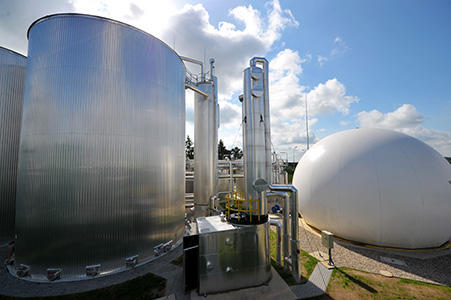The easy way to utilize biogas
Overview
Sulfothane is a combination of an alkaline scrubber column combined with a biological alkalinity recovery step including the production of elemental sulfur. The scrubber column is operated in counter-current mode resulting in efficient removal of H2S, achieving concentrations of less than 100 ppm and removal efficiencies exceeding 99%.
Standard design units are offered for biogas flows ranging from 100 to 1,500 Nm3/h and handling sulfur loads of 10 to 500 kgS/day. The units are factory tested and pre-commissioned and are designed for easy transportation, installation and maintenance. All materials are selected in industrial standards for long life time and durability. For larger capacities, multiple units can be placed in parallel or a tailor-made design can be applied.
Once the Sulfothane process has removed the hydrogen sulfide, the purified biogas can be used as a renewable energy source to generate heat (e.g. in a boiler) or electricity (e.g. in a combined heat power unit). Alternatively, it can be cleaned and compressed to be injected into the grid or used as vehicle fuel.
Not only does Sulfothane provide a source of green energy, it also recovers the elemental sulfur for beneficial reuse, turning an odorous compound into a useful product. The recovered sulfur can easily be used for sulphuric acid production or as a fertilizer.
How Sulfothane works
First, the biogas is led through a scrubber column where it is mixed and separated with slightly alkaline wash water (pH 8-9), thus removing H2S and some CO2. No air (O2 and N2) is added so the composition of the biogas remains almost unchanged except for the removal of H2S.
In a second step the loaded wash water enters a slightly aerated bioreactor where aerobic sulfur bacteria oxidize all H2S to produce elemental sulfur and recover alkalinity. The H2S-free (unloaded) wash water will be returned and reused in the scrubber. The separated sulfur sludge will be removed for further use or disposal.

Sulfothane is environmentally safe, has minimal power requirements and has a clogging-free scrubber which needs almost no maintenance. The process operates at ambient temperature and pressure, and requires almost no chemicals since only the chemicals lost in the small sulfur bleed stream have to be replaced.
- Suitable for gas streams with up to 50,000 ppm H2S.
- Very high (> 99%) H2S removal efficiencies can be obtained.
- Elemental sulfur recovery.
- Robust and highly reliable with uptime above 98%.
- Compact with a small footprint.
- Fully automated controls.
- Short start-up time.
- Low operational costs due to the biological regeneration step of caustic.
- Small requirements of caustic, water and nutrients.
- The process reduces the odor, toxicity and corrosiveness of the biogas.
- Easy maintenance: no risk of clogging in the scrubber column.
Applications
Services
- Process support and consultancy
Resources & Product range
Standard plant sizes for biogas production from anaerobic industrial wastewater treatment
Flow ranges: 50 to 2,500 Nm3/h
Concentration: 1,000 to 30,000 ppm H2S
Sulfur loads: 30/50 to 500 kg S/d
FAQ about Sulfothane™
What is biogas?
Biogas is an environmentally friendly, renewable energy source that is produced in an oxygen-free environment when bacteria digest organic matter such as food scraps and animal waste. This process is called anaerobic digestion.
Why is it important to remove sulfur compounds from biogas?
Hydrogen sulfide, also known as H2S, is a colorless and malodorous gas (comparable to the smell of rotten egg) generated by the anaerobic digestion of organic matter and biosolids. It is important to remove sulfur compounds from biogas because they are extremely flammable, hazardous to human health and corrosive to equipment.
How does biogas benefit industries?
Biogas is a renewable source of energy of which production is growing steadily. Indeed, more and more industries from various sectors are setting up biogas production plants with the final objective of producing electricity, methanol and steam that will be used in various applications such as cooking, drying, cooling, heating, etc.
Case Studies

ElPozó Alimentación, a Spanish company with more than 60 years of history located in Alhama de Murcia, is one of the most important food industries in Europe and, in addition, a company committed to sustainable development and environmental protection. Proof of this commitment are the more than 11.5 million euros allocated to date for the purification of wastewater, the energy recovery of its sludge and actions aimed at reducing its water footprint. For more than a decade now, Veolia Water Technologies has been responding to these challenges, offering ElPozo Alimentación sustainable and efficient technological solutions for water treatment, designed to increase process performance while respecting the commitment to sustainability and promoting a circular economy.

Jack Link’s, a leading protein snack producer, was in need of a water treatment solution at its facility in Alpena, South Dakota. Previously, their effluent was discharged directly into the sewer system, and the municipal treatment plant became overloaded due to the plant's increased production and high biological oxygen demand (BOD) loads. Jack Link's entrusted Veolia Water Technologies to develop a process that would solve the problem of the plant's high BOD discharges, while simultaneously creating biogas as a by-product to reduce the plant's energy costs.

Aptunion, a French company specializing in ingredients for the food industry, needed to ensure the sustainability of its site by reducing environmental and operating cost while increasing the capacity of their plant for production of more green energy. To meet their needs, they awarded Veolia Water Technologies to design and install an additional treatment plant using Biobed® Advanced EGSB, Sulfothane™, and MemGas™ technologies, thus allowing them to treat 1,600 m3 of wastewater per day while producing 200 Nm3 of biogas per hour.








